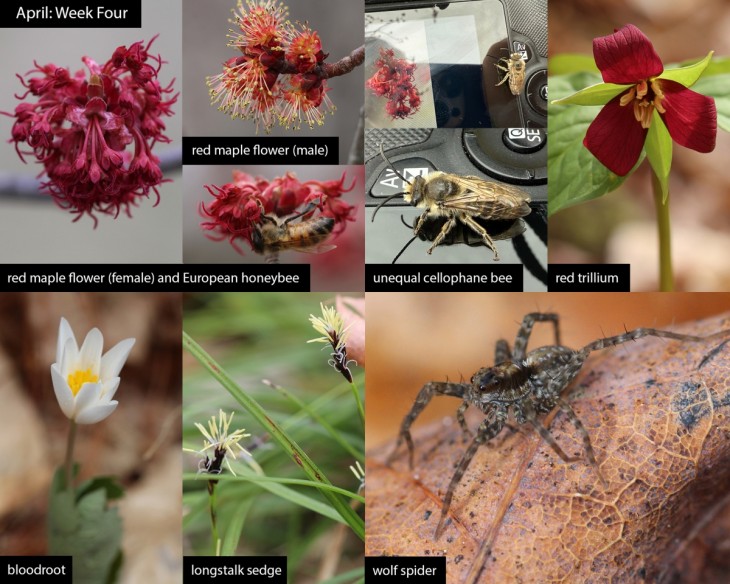This week in the woods, we’ve admired the clustered flowers of red maple – as have some pollinators. The stubby, seed-producing female flowers (usually red) and pollen-producing male flowers (usually yellowish, with tiny pollen-producing anthers) emerge earlier than many other flowers in our region and before their own trees’ leaves do. The females’ stigmas catch wind-borne pollen and, when fertilized, mature into fruit later in the summer.
Red maples rely on wind for pollination, prioritizing sheer aerodynamics over visual flashiness and seductive scent – which didn’t stop an (introduced) European honeybee from admiring some of the female flowers as much as we did. And when we examined our own photos, an unequal cellophane bee even seemed attracted enough to the image alone to visit our camera’s LCD screen. Also called polyester or plaster bees, for the lining of their underground winter chambers, these common, native, solitary bees emerge from the earth and become active earlier than most other bees in the spring. The Vermont Center for Ecostudies’ Vermont Atlas of Life notes that adults are most often found on flowering trees such as maples and willows but will visit just about any flower – and also sap buckets.
We’ve seen a number of introduced early-blooming flowers out in the woods and along the roads in recent weeks: mezereon, colt’s foot, snowdrops, crocuses, and ground ivy. Two of the earliest and most common native wildflowers showed themselves as well: red trillium (also called purple trillium, wake-robin, and stinking Benjamin) and bloodroot. These spring bloomers require direct sunlight and rush to fruit within weeks of blooming and complete their reproductive cycle before the tree canopy closes. Neither offers nectar to entice pollinators, only pollen. Tripartite in petal, stepal, and leaf, red trillium relies on carrion-eating flies and beetles fooled by its rotting smell (also compared to that of wet dog). Named for its roots’ reddish sap, bloodroot conserves pollen by closing its white petals around its stamens when the temperature dips below 47 degrees, when most pollinators pause foraging. To encourage cross-pollination, the female stigma becomes receptive before the male anthers do, but if the flower fails to attract sufficient insect pollination within a few days of opening, the anthers bend to touch the stigma and for the flower to self-pollinate. Longstalk sedge favors similar rich woodlands and has put up its spiked inflorescence. All three of these plants (and 4.5 percent of all plants) produce seeds that are ant dispersed. Ants carry the seeds back to their nests and remove the elaiosome, the attached food body rich in lipids, carbohydrates, vitamins, and protein. Larvae eat the elaiosome, while the seed gets discarded in the same heap as ant droppings and dead ants – the perfect place to germinate.
Among the same leaf litter these flowering plants sprung from, this wolf spider scampered and stopped. Accomplished hunters, wolf spiders rely on speed and surprise rather than webs. In an adaptation unique to wolf spiders, females carry their egg sac on their spinnerets, dragging it behind them while they forage but keeping it protected. They mend tears in the sac and manage sun exposure in order to maintain the ideal incubation temperature range. Once hatched, the spiderlings ride upon the mother’s back until maturity.
What have you noticed in the woods this week? Submit a recent photo for possible inclusion in our monthly online Reader Photo Gallery.



Discussion *